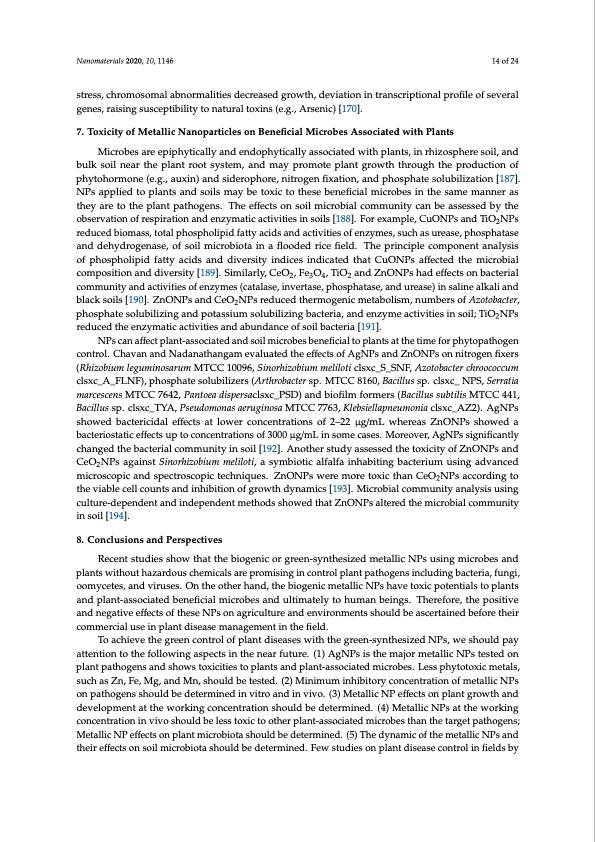
PDF Publication Title:
Text from PDF Page: 014
Nanomaterials 2020, 10, 1146 14 of 24 stress, chromosomal abnormalities decreased growth, deviation in transcriptional profile of several genes, raising susceptibility to natural toxins (e.g., Arsenic) [170]. 7. Toxicity of Metallic Nanoparticles on Beneficial Microbes Associated with Plants Microbes are epiphytically and endophytically associated with plants, in rhizosphere soil, and bulk soil near the plant root system, and may promote plant growth through the production of phytohormone (e.g., auxin) and siderophore, nitrogen fixation, and phosphate solubilization [187]. NPs applied to plants and soils may be toxic to these beneficial microbes in the same manner as they are to the plant pathogens. The effects on soil microbial community can be assessed by the observation of respiration and enzymatic activities in soils [188]. For example, CuONPs and TiO2NPs reduced biomass, total phospholipid fatty acids and activities of enzymes, such as urease, phosphatase and dehydrogenase, of soil microbiota in a flooded rice field. The principle component analysis of phospholipid fatty acids and diversity indices indicated that CuONPs affected the microbial composition and diversity [189]. Similarly, CeO2, Fe3O4, TiO2 and ZnONPs had effects on bacterial community and activities of enzymes (catalase, invertase, phosphatase, and urease) in saline alkali and black soils [190]. ZnONPs and CeO2NPs reduced thermogenic metabolism, numbers of Azotobacter, phosphate solubilizing and potassium solubilizing bacteria, and enzyme activities in soil; TiO2NPs reduced the enzymatic activities and abundance of soil bacteria [191]. NPs can affect plant-associated and soil microbes beneficial to plants at the time for phytopathogen control. Chavan and Nadanathangam evaluated the effects of AgNPs and ZnONPs on nitrogen fixers (Rhizobium leguminosarum MTCC 10096, Sinorhizobium meliloti clsxc_S_SNF, Azotobacter chroococcum clsxc_A_FLNF), phosphate solubilizers (Arthrobacter sp. MTCC 8160, Bacillus sp. clsxc_ NPS, Serratia marcescens MTCC 7642, Pantoea dispersaclsxc_PSD) and biofilm formers (Bacillus subtilis MTCC 441, Bacillus sp. clsxc_TYA, Pseudomonas aeruginosa MTCC 7763, Klebsiellapneumonia clsxc_AZ2). AgNPs showed bactericidal effects at lower concentrations of 2–22 μg/mL whereas ZnONPs showed a bacteriostatic effects up to concentrations of 3000 μg/mL in some cases. Moreover, AgNPs significantly changed the bacterial community in soil [192]. Another study assessed the toxicity of ZnONPs and CeO2NPs against Sinorhizobium meliloti, a symbiotic alfalfa inhabiting bacterium using advanced microscopic and spectroscopic techniques. ZnONPs were more toxic than CeO2NPs according to the viable cell counts and inhibition of growth dynamics [193]. Microbial community analysis using culture-dependent and independent methods showed that ZnONPs altered the microbial community in soil [194]. 8. Conclusions and Perspectives Recent studies show that the biogenic or green-synthesized metallic NPs using microbes and plants without hazardous chemicals are promising in control plant pathogens including bacteria, fungi, oomycetes, and viruses. On the other hand, the biogenic metallic NPs have toxic potentials to plants and plant-associated beneficial microbes and ultimately to human beings. Therefore, the positive and negative effects of these NPs on agriculture and environments should be ascertained before their commercial use in plant disease management in the field. To achieve the green control of plant diseases with the green-synthesized NPs, we should pay attention to the following aspects in the near future. (1) AgNPs is the major metallic NPs tested on plant pathogens and shows toxicities to plants and plant-associated microbes. Less phytotoxic metals, such as Zn, Fe, Mg, and Mn, should be tested. (2) Minimum inhibitory concentration of metallic NPs on pathogens should be determined in vitro and in vivo. (3) Metallic NP effects on plant growth and development at the working concentration should be determined. (4) Metallic NPs at the working concentration in vivo should be less toxic to other plant-associated microbes than the target pathogens; Metallic NP effects on plant microbiota should be determined. (5) The dynamic of the metallic NPs and their effects on soil microbiota should be determined. Few studies on plant disease control in fields byPDF Image | Plant and Microbe-Based Synthesis of Metallic Nanoparticles

PDF Search Title:
Plant and Microbe-Based Synthesis of Metallic NanoparticlesOriginal File Name Searched:
nanomaterials-10-01146.pdfDIY PDF Search: Google It | Yahoo | Bing
Turbine and System Plans CAD CAM: Special for this month, any plans are $10,000 for complete Cad/Cam blueprints. License is for one build. Try before you buy a production license. More Info
Waste Heat Power Technology: Organic Rankine Cycle uses waste heat to make electricity, shaft horsepower and cooling. More Info
All Turbine and System Products: Infinity Turbine ORD systems, turbine generator sets, build plans and more to use your waste heat from 30C to 100C. More Info
CO2 Phase Change Demonstrator: CO2 goes supercritical at 30 C. This is a experimental platform which you can use to demonstrate phase change with low heat. Includes integration area for small CO2 turbine, static generator, and more. This can also be used for a GTL Gas to Liquids experimental platform. More Info
Introducing the Infinity Turbine Products Infinity Turbine develops and builds systems for making power from waste heat. It also is working on innovative strategies for storing, making, and deploying energy. More Info
Need Strategy? Use our Consulting and analyst services Infinity Turbine LLC is pleased to announce its consulting and analyst services. We have worked in the renewable energy industry as a researcher, developing sales and markets, along with may inventions and innovations. More Info
Made in USA with Global Energy Millennial Web Engine These pages were made with the Global Energy Web PDF Engine using Filemaker (Claris) software.
Infinity Turbine Developing Spinning Disc Reactor SDR or Spinning Disc Reactors reduce processing time for liquid production of Silver Nanoparticles.
| CONTACT TEL: 608-238-6001 Email: greg@infinityturbine.com | RSS | AMP |